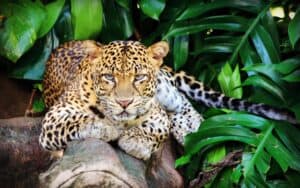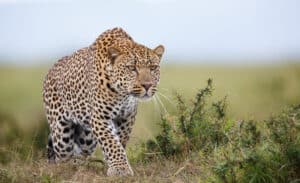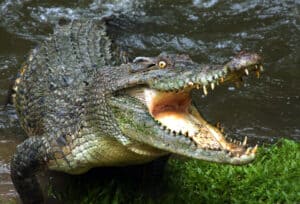Jaguars aren’t just stealthy predators on land, they’re equally as dangerous in the water. These apex predators are powerful, even stalking and ambushing other apex predators. Watch the incredible hunting prowess of the jaguar below.
Check Out the Video!
Jaguar vs. Caiman
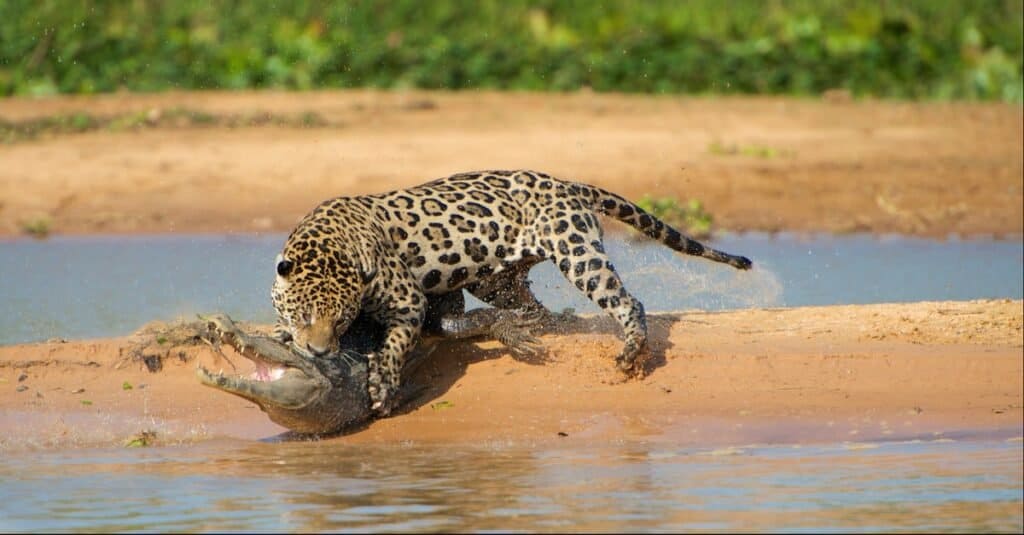
The stealthy hunt and lightening-quick attack of the jaguar offers the caiman little chance for defense.
©Gurkan Ozturk/Shutterstock.com
The clip above starts out with a shot of a jaguar swimming in muddy water with the narrator explaining that this isn’t an unusual scene as jaguars are the most aquatic of the big cats. The video was taken in Central Brazil and the jaguar is already engaging in its hunting behavior.
It’s “scanning the buffet line,” as the narrator puts it while it walks along the edge of the murky water with brush behind it. The cameraman pans to the right and the narrator explains that across the river, there are two unsuspecting caimans. The next shot is of the jaguar swimming in the water, its head barely visible.
The narrator points out the stealth with which the jaguar swims, not creating a lot of splashes as it makes its way over to ambush its prey. As the jaguar makes it over to the sandbar, it keeps its quiet approach. Once it’s gotten close enough it jumps up onto the sandbar, takes two steps, and heads for the back of the caiman’s neck.
The caiman barely has time to react and by the time it does, it’s too late. The narrator explains that with its bite, the jaguar disconnects the caiman’s nervous system — and you can see that it’s no longer trying to put up a fight.
How Do Jaguars Hunt?
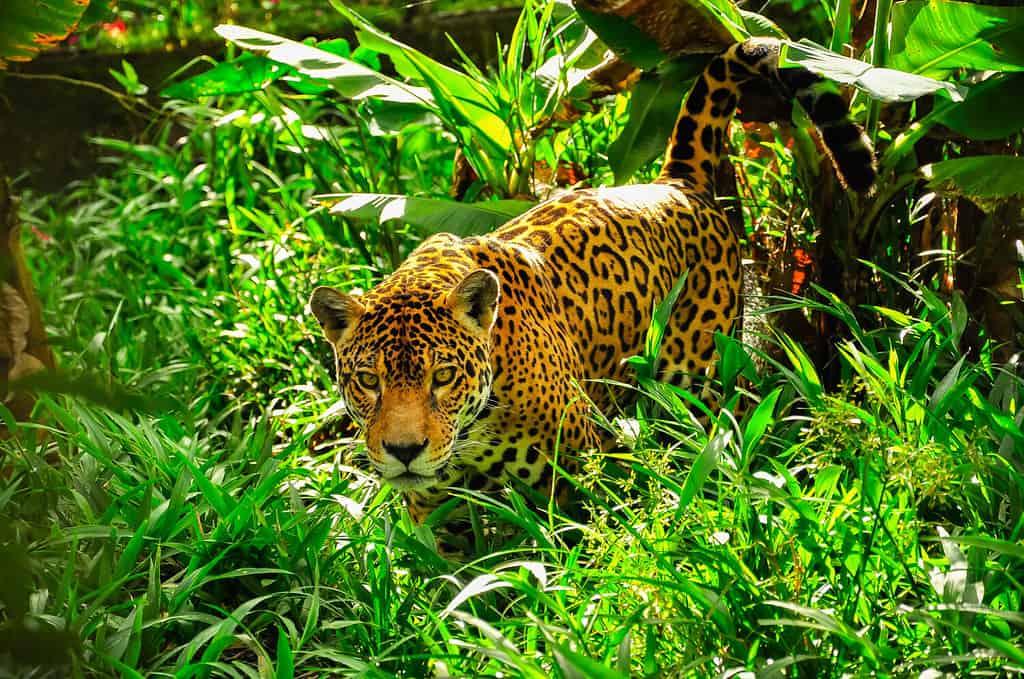
Jaguars hunt on the ground, in the water, and at night.
©Jo Reason/Shutterstock.com
When they’re on the ground, jaguars hunt their prey under the cover of nightfall. Although they’re speedy on land, they prefer the element of surprise. Instead of expending their energy on a full-on chase, they take on a slower hunting style, first stalking their prey.
Once they’ve gotten close enough, these muscle-bound cats ambush their prey and use their razor-sharp teeth and ridiculously strong jaw muscles to kill. Jaguars have the most powerful bite force of any big cat — a skull-crushing 1,500 PSI. If they spot prey in the water, like a caiman, they are not afraid of getting wet. They swim quite well, and caimans aren’t the only water-dwelling creatures they hunt.
They also go for turtles, fish, and whatever else they want.
How Do Caimans Defend Themselves?
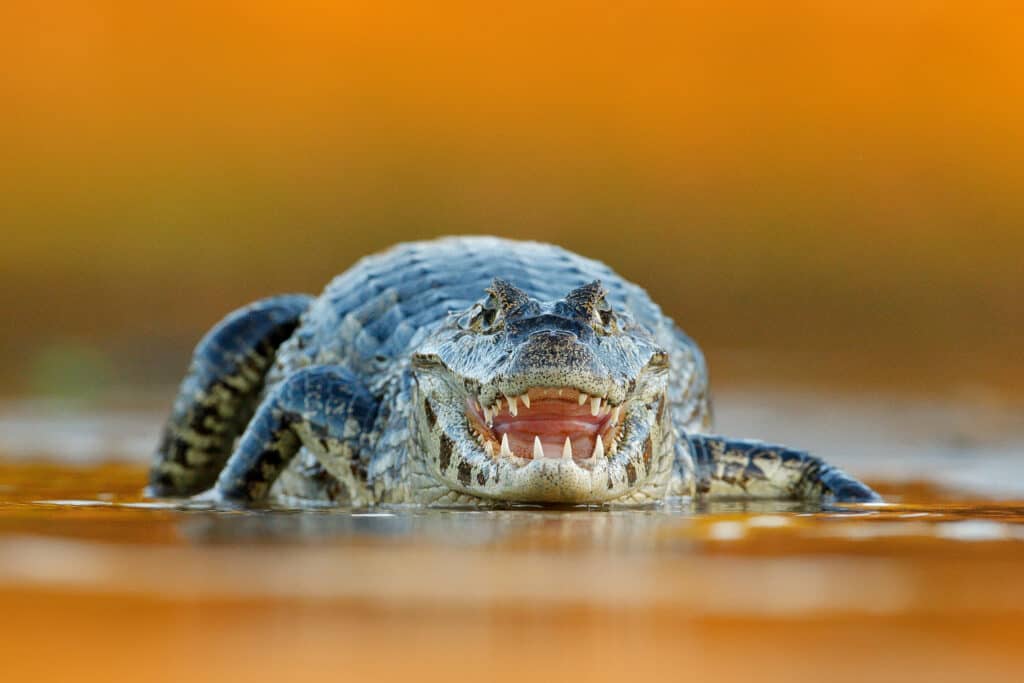
The caiman is an alligator and possesses all of its defensive capabilities.
©Ondrej Prosicky/Shutterstock.com
Caimans dwell in swampland, lakes, and rivers. Like jaguars, they’re also carnivores, feasting on waterfowl, fish, and crustaceans. Prey is swallowed whole and ground by stones in the gizzard. They’re generally considered docile but if they are threatened, they display aggression.
As members of the alligator family, caimans have a powerful bite force of 3,700 PSI capable of breaking bones and stronger than the jaws of the jaguar. Like their big cousins, most caimans use the classic “death roll” technique and are expert stalkers, often peeking out of the water with eyes only with their bodies submerged. Their flattened tails help with swimming but they can also be wielded as a weapon if needed.
Like jaguars, caimans are apex predators. Unfortunately, the jaguar is one of the few animals that prey on this formidable reptile.
How Big Do Caiman Get?
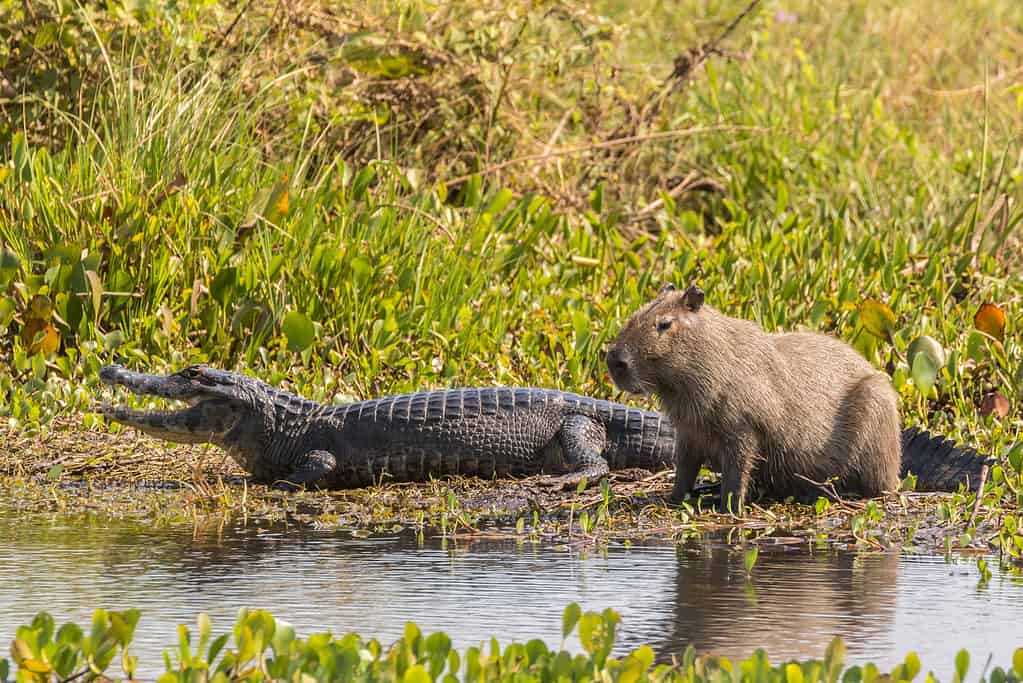
The caiman is a smaller member of the alligator family.
©Danita Delimont/Shutterstock.com
Within this group of species, the black caiman holds the distinction of being the largest. These lizards potentially pose a threat due to its imposing size, with a maximum length of approximately 15 feet.
The remaining species typically grow to lengths of around 2 to 3 feet, with the spectacled caiman achieving a maximum length of about over 3 feet. Furthermore, black caimans can reach sizes comparable to alligators, growing up to a remarkable twelve feet in the wild.
It’s important to note that caimans are not native to the United States.
Is it Normal for Jaguars to Hunt in the Water?

Jaguars are the most aquatic big cat.
©imageBROKER.com/Shutterstock.com
The jaguar’s shrinking habitat has caused it to master the swampy environment of the rain forest, resulting in a big cat with exceptional swimming skills. They may not be born to swim, but being able to travel through water at 6 miles an hour is impressive for a land mammal. In addition to having the most powerful bite force of all cats in its toolkit, this fierce feline can run up to 50 miles per hour and jump 10 feet high. Its name means “he who kills with one leap” — so this big cat’s hunting skills are legendary.
Caiman aren’t the only big prey on the jaguar’s menu: deer, capybaras, tapirs and other land animals are frequently ambushed at night. Jaguars have excellent night vision and are silent stalkers.
The photo featured at the top of this post is © iStock.com/UrmasPhotoCom
Thank you for reading! Have some feedback for us? Contact the AZ Animals editorial team.




